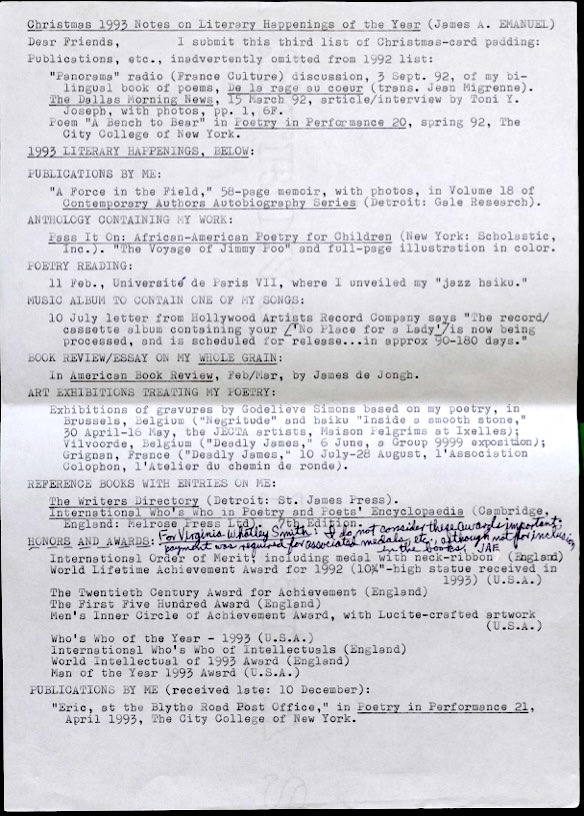1993: A Data Story
1993 was life changing for James A. Emanuel. It was a year that hinged between “repositories of memory” and a creative legacy of his future (Bench and Elswit par. 2). He was likely in the process of gathering his papers for collection at the Library of Congress. Friends such as Marie-France Plassard, a librarian, worked with him to get his materials together. And by 1997, Emanuel had received book entitled Library of Congress Acquisitions Manuscript Division 1994 - 1995 that confirmed he had “sent from Paris the first six cartons of his papers consisting of correspondence, poetry, and other writings, autobiographical material, notes, subject files, programs, daily calendars, a videocassette and tape recordings of interviews and readings, clippings, and printed material (4,000 items), 1935 - 95.” This extensive labor is not included in his “Christmas Notes.” Despite its absence, by the numbers, 1993 is among the most productive years even though his number of collaborators is at its lowest point. This quieter year was a catalyst for his creative peaks in terms of collaboration.
To understand why this year is so generative, we might look to Harmony Bench and Kate Elswit’s “The Body Is Not (Only) a Metaphor: Rethinking Embodiment.” The authors explore embodiment through performance studies and apply it to ways scholars can rethink visualization practices in digital humanities. They write, “bodies are articulated as experiential, in which practices of embodiment arrange knowledge, in which bodies stand as repositories of memory, in which they are recognized as in process, and in which physicality produces relationality (Bench and Elswit par. 2).” Emanuel’s “Christmas 1993 Notes” show this interconnection of the body as process, knowledge, and memory.

Figure 1. Christmas 1993 Notes on Literary Happenings.
In this light, the “Christmas 1993 Notes” reveal Emanuel’s as “in process,” arranging a new body of work. On February 11th at the Université of Paris VIII, Emanuel “unveiled [his] ‘jazz haiku’ (“Christmas 1993 Notes”). In a rare occurrence, this is his only poetry reading documented that year. There was no list of poems, no accompanying musician, and no formal title; two words are enough: jazz haiku. These two words are a type of data abbreviation; it is an abbreviation that understates Emanuel’s embodied knowledge of the haiku. Without the word “unveiled,” which gives the “jazz haiku” an adorned presence, readers might have placed greater emphasis on “HONORS AND AWARDS.” But Emanuel clarifies in his notes that the listed honors and awards were unimportant to him, as noted in his annotation to Virginia Whatley Smith. The “jazz haiku” in Emanuel’s “Christmas Notes” articulate abbreviation and expansion.
Figure 2. This pie chart shows how often different titles appear in James A. Emanuel’s “Christmas Notes.” Each color represents a different work, and the titles are listed around the edge of the chart. Click on a slice to see how many times that title is mentioned. You can also use the “Count of Title of Work” panel on the right to add or remove titles from the chart.
Across the sixteen-years of his “Christmas Notes, no form appears more than the haiku. These haiku-related activities range from the undocumented acts of drafting poems, rehearsing with musicians like Chansse Evans, forging visual aesthetics with Godelieve Simons, and mediating translations with Jean Migrenne to the documented acts of publishing, exhibiting, and reading these works. Emanuel’s experiential practices in process inform the output of the “What Emanuel Wrote, By the Numbers (pie chart).” Haikus make up 86% of all titles in the corpus. Though economical, the haiku takes up space through volume and multiplicity. One poem of seventeen syllables could be published, performed, translated, engraved, and disseminated internationally. Emanuel’s most active title—“Inside a Smooth Stone”—was first published in African American Review in 1992 and was later engraved by Godelieve Simons. The haiku’s meaning and its mode was eloquent, which is evident in its sixteen entries over eight years. The poem was exhibited in Belgium, France, and Scotland. In fact, “Smooth Stone” is even a part of Belgium’s official national collection ("Smooth Stone"). Works like “Inside a Smooth Stone” chisel Emanuel’s embodied connections.
Works Cited
Bench, Harmony, and Kate Elswit. “The Body Is Not (Only) a Metaphor: Rethinking Embodiment in DH.” Debates in Digital Humanities 2023, edited by Matthew K. Gold and Lauren F. Klein, University of Minnesota Press, 2023.
Emanuel, James A. “Christmas 1993 Notes on Literary Happenings.” MS Box 14, Folder 7, “Biographical Materials, 1987 – 2003, 2007, Undated,” James A. Emanuel papers, 1922 - 2018. Library of Congress. Washington, D.C.
Library of Congress Acquisitions Manuscript Division 1994–1995. Library of Congress, 1997.
“Smooth Stone.” 7 Profils de James Emanuel / 7 Profiles of James Emanuel, edited by Godelieve Simons, Grav’i Sim, 2006.